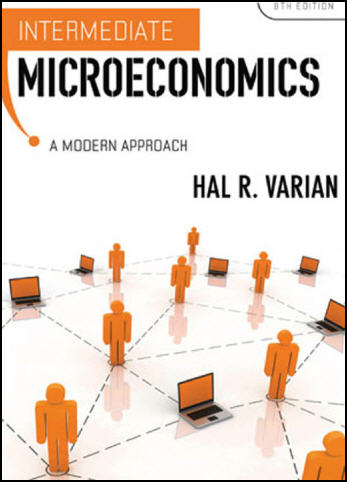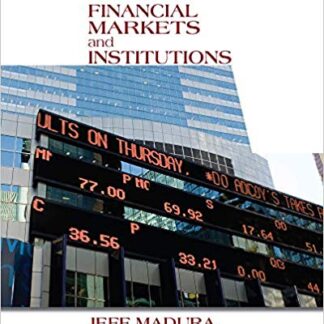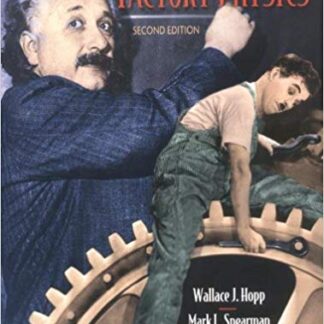Description
Intermediate Microeconomics: A Modern Approach 8th Edition by Hal R. Varian, ISBN-13: 978-0393934243
[PDF eBook eTextbook] – Available Instantly
- Publisher: W. W. Norton & Company; Eighth edition (December 3, 2009)
- Language: English
- 739 pages
- ISBN-10: 0393934241
- ISBN-13: 978-0393934243
The #1 best-selling intermediate microeconomics text in the world is still the most modern and contemporary.
1 The Market
Constructing a Model
1
Optimization and Equilibrium
3
The Demand Curve
3
The Supply Curve
5
Market Equilibrium
7
Comparative Statics
9
Other Ways to Allocate Apartments
11
The Discriminating Monopolist
The Ordinary Monopolist
Rent Control
Which Way Is Best?
14
Pareto Efficiency
15
Comparing Ways to Allocate Apartments
16
Equilibrium in the Long Run
17
Summary
18
Review Questions
19
2 Budget Constraint
The Budget Constraint
20
Two Goods Are Often Enough
21
Properties of the Budget Set
22
How the Budget Line Changes
24
The Numeraire
26
Taxes, Subsidies, and Rationing
26
Example: The Food Stamp Program
Budget Line Changes
31
Summary
31
Review Questions
32
3 Preferences
Consumer Preferences
34
Assumptions about Preferences
35
Indifference Curves
36
Examples of Preferences
37
Perfect Substitutes
Perfect Complements
Bads
Neutrals
Satiation
Discrete Goods
Well-Behaved Preferences
44
The Marginal Rate of Substitution
48
Other Interpretations of the MRS
50
Behavior of the MRS
51
Summary
52
Review Questions
52
4 Utility
Cardinal Utility
57
Constructing a Utility Function
58
Some Examples of Utility Functions
59
Example: Indifference Curves from Utility Perfect Substitutes
Perfect Complements
Quasilinear Preferences
Cobb-Douglas Preferences
Marginal Utility
65
Marginal Utility and MRS
66
Utility for Commuting
67
Summary
69
Review Questions
70
Appendix
70
Example: Cobb-Douglas Preferences
5 Choice
Optimal Choice
73
Consumer Demand
78
Some Examples
78
Perfect Substitutes
Perfect Complements
Neutrals and Bads
Discrete Goods
Concave Preferences
Cobb-Douglas Preferences
Estimating Utility Functions
83
Implications of the MRS Condition
85
Choosing Taxes
87
Summary
89
Review Questions
89
Appendix
90
Example: Cobb-Douglas Demand Functions
6 Demand
Normal and Inferior Goods
96
Income Offer Curves and Engel Curves
97
Some Examples
99
Perfect Substitutes
Perfect Complements
Cobb-Douglas Preferences
Homothetic Preferences
Quasilinear Preferences
Ordinary Goods and Giffen Goods
104
The Price Offer Curve and the Demand Curve
106
Some Examples
107
Perfect Substitutes
Perfect Complements
A Discrete Good
Substitutes and Complements
111
The Inverse Demand Function
112
Summary
114
Review Questions
115
Appendix
115
7 Revealed Preference
The Idea of Revealed Preference
119
From Revealed Preference to Preference
120
Recovering Preferences
122
The Weak Axiom of Revealed Preference
124
Checking WARP
125
The Strong Axiom of Revealed Preference
128
How to Check SARP
129
Index Numbers
130
Price Indices
132
Example: Indexing Social Security Payments
Summary
135
Review Questions
135
8 Slutsky Equation
The Substitution Effect
137
Example: Calculating the Substitution Effect
The Income Effect
141
Example: Calculating the Income Effect
Sign of the Substitution Effect
142
The Total Change in Demand
143
Rates of Change
144
The Law of Demand
147
Examples of Income and Substitution Effects
147
Example: Rebating a Tax
Example: Voluntary Real Time Pricing
Another Substitution Effect
153
Compensated Demand Curves
155
Summary
156
Review Questions
157
Appendix
157
Example: Rebating a Small Tax
9 Buying and Selling
Net and Gross Demands
160
The Budget Constraint
161
Changing the Endowment
163
Price Changes
184
Offer Curves and Demand Curves
167
The Slutsky Equation Revisited
168
Use of the Slut-sky
Equation
172
Example: Calculating the Endowment Income Effect
Labor Supply
173
The Budget Constraint
Comparative Statics of Labor Supply
174
Example: Overtime and the Supply of Labor
Summary
178
Review Questions
179
Appendix
179
10 Intertemporal Choice
The Budget Constraint
182
Preferences for Consumption
185
Comparative Statics
186
The Slutsky Equation and Intertemporal Choice
187
Inflation
189
Present Value: A Closer Look
191
Analyzing Present Value for Several Periods
193
Use of Present Value
194
Example: Valuing a Stream of Payments
Example: The True Cost of a Credit Card
Example: Extending Copyright
Bonds
198
Example: Installment Loans
Taxes
200
Example: Scholarships and Savings
Choice of the Interest Rate
201
Summary
202
Review Questions
202
11 Asset Markets
Rates of Return
203
Arbitrage and Present Value
205
Adjustments for Differences among Assets
205
Assets with Consumption Returns
206
Taxation of Asset Returns
207
Market Bubbles
208
Applications
209
Depletable Resources
When to Cut a Forest
Example: Gasoline Prices during the Gulf War
Financial Institutions
213
Summary
214
Review Questions
215
Appendix
215
12 Uncertainty
Contingent Consumption
217
Example: Catastrophe Bonds
Utility Functions and Probabilities
222
Example: Some Examples of Utility Functions
Expected Utility
223
Why Expected Utility Is Reasonable
224
Risk Aversion
226
Example: The Demand for Insurance
Diversification
230
Risk Spreading
230
Role of the Stock Market
231
Summary
232
Review Questions
232
Appendix
233
Example: The Effect of Taxation on Investment in Risky Assets
13 Risky Assets
Mean-Variance Utility
236
Measuring Risk
241
Counterparty Risk
243
Equilibrium in a Market for Risky Assets
243
How Returns Adjust
245
Example: Value at Risk
Example: Ranking Mutual Funds
Summary
249
Review Questions
250
14 Consumer’s Surplus
Demand for a Discrete Good
252
Constructing Utility from Demand
253
Other Interpretations of Consumer’s Surplus
254
From Consumer’s Surplus to Consumers’ Surplus
255
Approximating a Continuous Demand
255
Quasilinear Utility
255
Interpreting the Change in Consumer’s Surplus
256
Example: The Change in Consumer’s Surplus
Compensating and Equivalent Variation
258
Example: Compensating and Equivalent Variations
Example: Compensating and Equivalent Variation for Quasilinear Preferences
Producer’s Surplus
262
Benefit-Cost Analysis
264
Rationing
Calculating Gains and Losses
266
Summary
267
Review Questions
267
Appendix
268
Example: A Few Demand Functions
Example: CV, EV, and Consumer’s Surplus
15 Market Demand
From Individual to Market Demand
270
The Inverse Demand Function
272
Example: Adding Up “Linear” Demand Curves
Discrete Goods
273
The Extensive and the Intensive Margin
273
Elasticity
274
Example: The Elasticity of a Linear Demand Curve
Elasticity and Demand
276
Elasticity and Revenue
277
Example: Strikes and Profits
Constant Elasticity Demands
280
Elasticity and Marginal Revenue
281
Example: Setting a Price
Marginal Revenue Curves
283
Income Elasticity
284
Summary
285
Review Questions
286
Appendix
287
Example: The Leifer Curve
Example: Another Expression for Elasticity
16 Equilibrium
Supply
293
Market Equilibrium
293
Two Special Cases
294
Inverse Demand and Supply Curves
295
Example: Equilibrium with Linear Curves
Comparative Statics
297
Example: Shifting Both Curves
Taxes
298
Example: Taxation with Linear Demand and Supply
Passing Along a Tax
302
The Deadweight Loss of a Tax
304
Example: The Market for Loans
Example: Food Subsidies
Example: Subsidies in Iraq
Pareto Efficiency
310
Example: Waiting in Line
Summary
313
Review Questions
313
17 Auctions
Classification of Auctions
316
Bidding Rules
Auction Design
317
Other Auction Forms
320
Example: Late Bidding on eBay
Position Auctions
322
Two Bidders
More Than Two Bidders
Quality Scores
Problems with Auctions
326
Example: Taking Bids Off the Wall
The Winner’s Curse
327
Stable Marriage Problem
327
Mechanism Design
329
Summary
331
Review Questions
331
18 Technology
Inputs and Outputs
332
Describing Technological Constraints
333
Examples of Technology
334
Fixed Proportions
Perfect Substitutes
Cobb-Douglas
Properties of Technology
336
The Marginal Product
338
The Technical Rate of Substitution
338
Diminishing Marginal Product
339
Diminishing Technical Rate of Substitution
339
The Long Run and the Short Run
340
Returns to Scale
340
Example: Datacenters
Example: Copy Exactly!
Summary
343
Review Questions
344
19 Profit Maximization
Profits
345
The Organization of Firms
347
Profits and Stock Market Value
347
The Boundaries of the Firm
349
Fixed and Variable Factors
350
Short-Run Profit Maximization
350
Comparative Statics
352
Profit Maximization in the Long Run
353
Inverse Factor Demand Curves
354
Profit Maximization and Returns to Scale
355
Revealed Profitability
356
Example: How Do Farmers React to Price Supports?
Cost Minimization
360
Summary
360
Review Questions
361
Appendix
362
20 Cost Minimization
Cost Minimization
364
Example: Minimizing Costs for Specific Technologies
Revealed Cost Minimization
368
Returns to Scale and the Cost Function
369
Long-Run and Short-Run Costs
371
Fixed and Quasi-Fixed Costs
373
Sunk Costs
373
Summary
374
Review Questions
374
Appendix
375
21 Cost Curves
Average Costs
378
Marginal Costs
380
Marginal Costs and Variable Costs
382
Example: Specific Cost Curves
Example: Marginal Cost Curves for Two Plants
Cost Curves for Online Auctions
386
Long-Run Costs
387
Discrete Levels of Plant Size
389
Long-Run Marginal Costs
390
Summary
391
Review Questions
392
Appendix
393
22 Firm Supply
Market Environments
395
Pure Competition
396
The Supply Decision of a Competitive Firm
398
An Exception
400
Another Exception
401
Example: Pricing Operating Systems
The Inverse Supply Function
403
Profits and Producer’s Surplus
403
Example: The Supply Curve for a Specific Cost Function
The Long-Run Supply Curve of a Firm
407
Long-Run Constant Average Costs
409
Summary
410
Review Questions
411
Appendix
411
23 Industry Supply
Short-Run Industry Supply
413
Industry Equilibrium in the Short Run
414
Industry Equilibrium in the Long Run
415
The Long-Run Supply Curve
417
Example: Taxation in the Long Run and in the Short Run
The Meaning of Zero Profits
421
Fixed Factors and Economic Rent
422
Example: Taxi Licenses in New York City
Economic Rent
424
Rental Rates and Prices
426
Example: Liquor Licenses
The Politics of Rent
427
Example: Farming the Government
Energy Policy
429
Two-Tiered Oil Pricing
Price Controls
The Entitlement Program
Carbon Tax Versus Cap and Trade
433
Optimal Production of Emissions
A Carbon Tax
Cap and Trade
Summary
437
Review Questions
437
24 Monopoly
Maximizing Profits
440
Linear Demand Curve and Monopoly
441
Markup Pricing
443
Example: The Impact of Taxes on a Monopolist
Inefficiency of Monopoly
445
Deadweight Loss of Monopoly
447
Example: The Optimal Life of a Patent
Example: Patent Thickets
Example: Managing the Supply of Potatoes
Natural Monopoly
451
What Causes Monopolies?
454
Example: Diamonds Are Forever
Example: Pooling in Auction Markets
Example: Price Fixing in Computer Memory Markets
Summary
458
Review Questions
458
Appendix
459
25 Monopoly Behavior
Price Discrimination
462
First-Degree Price Discrimination
462
Example: First-degree Price Discrimination in Practice
Second-Degree Price Discrimination
465
Example: Price Discrimination in Airfares
Example: Prescription Drug Prices
Third-Degree Price Discrimination
469
Example: Linear Demand Curves
Example: Calculating Optimal Price Discrimination
Example: Price Discrimination in Academic Journals
Bundling
474
Example: Software Suites
Two-Part Tariffs
475
Monopolistic Competition
476
A Location Model of Product Differentiation
480
Product Differentiation
482
More Vendors
483
Summary
484
Review Questions
484
26 Factor Markets
Monopoly in the Output Market
485
Monopsony
488
Example: The Minimum Wage
Upstream and Downstream Monopolies
492
Summary
494
Review Questions
495
Appendix
495
27 Oligopoly
Choosing a Strategy
498
Example: Pricing Matching
Quantity Leadership
499
The Follower’s Problem
The Leader’s Problem
Price Leadership
504
Comparing Price Leadership and Quantity Leadership
507
Simultaneous Quantity Setting
507
An Example of Cournot Equilibrium
509
Adjustment to Equilibrium
510
Many Firms in Cournot Equilibrium
511
Simultaneous Price Setting
512
Collusion
513
Punishment Strategies
515
Example: Price Matching and Competition
Example: Voluntary Export Restraints
Comparison of the Solutions
519
Summary
519
Review Questions
520
28 Game Theory
The Payoff Matrix of a Game
522
Nash Equilibrium
524
Mixed Strategies
525
Example: Rock Paper Scissors
The Prisoner’s Dilemma
527
Repeated Games
529
Enforcing a Cartel
530
Example: Tit for Tat in Airline Pricing
Sequential Games
532
A Game of Entry Deterrence
534
Summary
536
Review Questions
537
29 Game Applications
Best Response Curves
538
Mixed Strategies
540
Games of Coordination
542
Battle of the Sexes
Prisoner’s Dilemma
Assurance Games
Chicken
How to Coordinate
Games of Competition
546
Games of Coexistence
551
Games of Commitment
553
The Frog and the Scorpion
The Kindly Kidnapper
When Strength Is Weakness
Savings and Social Security
Hold Up
Bargaining
561
The Ultimatum Game
Summary
584
Review Questions
565
30 Behavioral Economics
Framing Effects in Consumer Choice
567
The Disease Dilemma
Anchoring Effects
Bracketing
Too Much Choice
Constructed Preferences
Uncertainty
571
Law of Small Numbers
Asset Integration and Loss Aversion
Time
574
Discounting
Self-control
Example: Overconfidence
Strategic Interaction and Social Norms
576
Ultimatum Game
Fairness
Assessment of Behavioral Economics
578
Summary
579
Review Questions
581
31 Exchange
The Edgeworth Box
583
Trade
585
Pareto Efficient Allocations
586
Market Trade
588
The Algebra of Equilibrium
590
Walras’ Law
592
Relative Prices
593
Example: An Algebraic Example of Equilibrium
The Existence of Equilibrium
595
Equilibrium and Efficiency
596
The Algebra of Efficiency
597
Example: Monopoly in the Edgeworth Box
Efficiency and Equilibrium
600
Implications of the First Welfare Theorem
602
Implications of the Second Welfare Theorem
604
Summary
606
Review Questions
607
Appendix
607
32 Production
The Robinson Crusoe Economy
609
Crusoe, Inc.
611
The Firm
612
Robinson’s Problem
613
Putting Them Together
613
Different Technologies
615
Production and the First Welfare Theorem
617
Production and the Second Welfare Theorem
618
Production Possibilities
618
Comparative Advantage
620
Pareto Efficiency
622
Castaways, Inc.
624
Robinson and Friday as Consumers
626
Decentralized Resource Allocation
627
Summary
628
Review Questions
628
Appendix
629
33 Welfare
Aggregation of Preferences
632
Social Welfare Functions
634
Welfare Maximization
636
Individualistic Social Welfare Functions
638
Fair Allocations
639
Envy and Equity
640
Summary
642
Review Questions
642
Appendix
643
34 Externalities
Smokers and Nonsmokers
645
Quasilinear Preferences and the Come Theorem
648
Production Externalities
650
Example: Pollution Vouchers
Interpretation of the Conditions
655
Market Signals
658
Example: Bees and Almonds
The Tragedy of the Commons
659
Example: Overfishing
Example: New England Lobsters
Automobile Pollution
663
Summary
665
Review Questions
665
35 Information Technology
Systems Competition
668
The Problem of Complements
668
Relationships among Complementors
Example: Apple’s iPod and iTune.s
Example: Who Makes an iPod?
Example: AdWords and AdSense
Lock-In
674
A Model of Competition with Switching Costs
Example: Online Bill Payment
Example: Number Portability on Cell Phones
Network Externalities
678
Markets with Network Externalities
678
Market Dynamics
680
Example: Network Externalities in Computer Software
Implications of Network Externalities
684
Example: The Yellow Pages
Example: Radio Ads
Two-sided Markets
686
A Model of Two-sided Markets
Rights Management
687
Example: Video Rental
Sharing Intellectual Property
689
Example: Online Two-sided Markets
Summary
692
Review Questions
693
36 Public Goods
When to Provide a Public Good?
695
Private Provision of the Public Good
699
Free Riding
699
Different Levels of the Public Good
701
Quasilinear Preferences and Public Goods
703
Example: Pollution Revisited
The Free Rider Problem
705
Comparison to Private Goods
707
Voting
708
Example: Agenda Manipulation
The Vickrey-Clarke-Groves Mechanism
711
Groves Mechanism
The VCG Mechanism
Examples of VCG
713
Vickrey Auction
Clarke-Groves Mechanism
Problems with the VCG
714
Summary
715
Review Questions
716
Appendix
716
37 Asymmetric Information
The Market for Lemons
719
Quality Choice
720
Choosing the Quality
Adverse Selection
722
Moral Hazard
724
Moral Hazard and Adverse Selection
725
Signaling
726
Example: The Sheepskin Effect
Incentives
730
Example: Voting Rights in the Corporation
Example: Chinese Economic Reforms
Asymmetric Information
735
Example: Monitoring Costs
Example: The Grameen Bank
Summary
738
Review Questions
739
Mathematical Appendix
Functions
A1
Graphs
A2
Properties of Functions
A2
Inverse Functions
A3
Equations and Identities
A3
Linear Functions
A4
Changes and Rates of Change
A4
Slopes and Intercepts
A5
Absolute Values and Logarithms
A6
Derivatives
A6
Second Derivatives
A7
The Product Rule and the Chain Rule
A8
Partial Derivatives
A8
Optimization
A9
Constrained Optimization
A10
Answers
A11
Index
A31
What makes us different?
• Instant Download
• Always Competitive Pricing
• 100% Privacy
• FREE Sample Available
• 24-7 LIVE Customer Support






